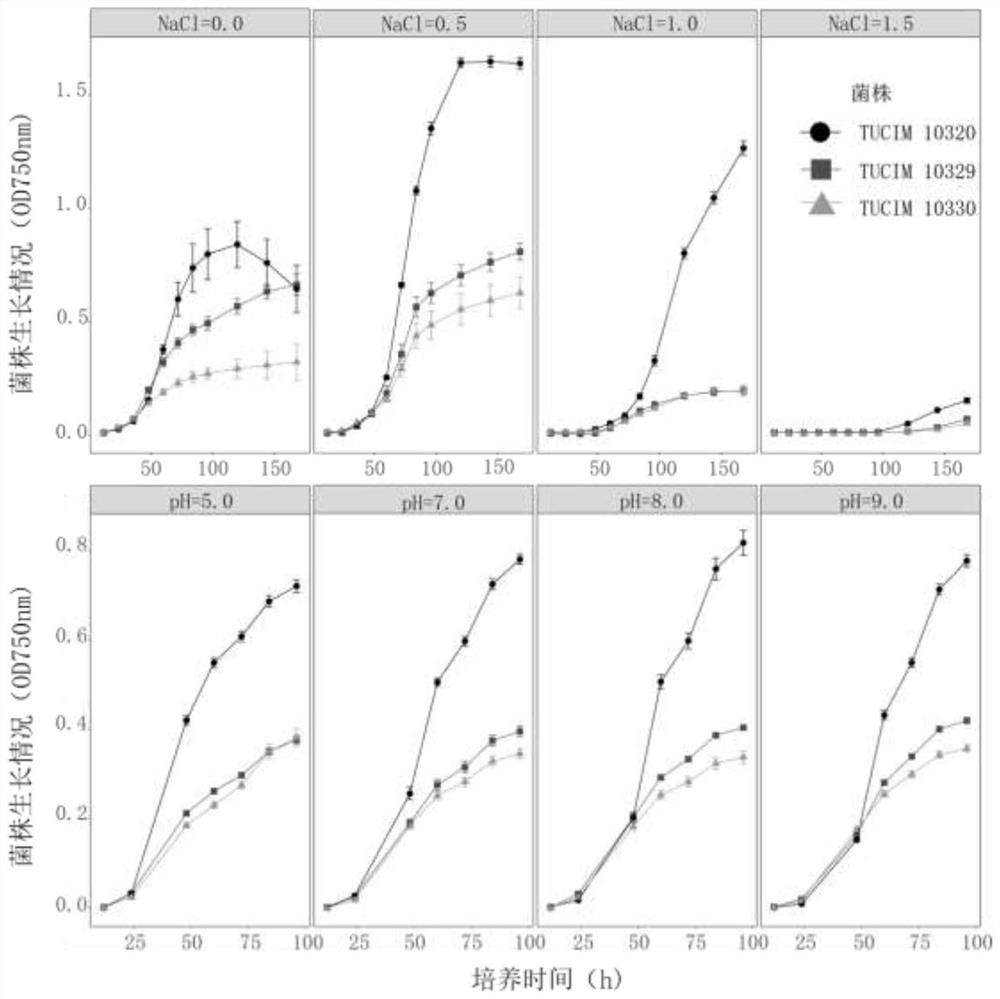A saline-alkali tolerant Trichoderma aculeatus and its application
A technology of Trichoderma aculeatus and salt-alkali resistance, which is applied in the biological field and can solve the problems of few microbial groups, difficulty in rooting and standing of crops, poor physical and chemical properties, etc.
- Summary
- Abstract
- Description
- Claims
- Application Information
AI Technical Summary
Problems solved by technology
Method used
Image
Examples
Embodiment 1
[0028] Example 1: Isolation and identification of Trichoderma aculeatus TUCIM 10320
[0029] Trichoderma aculeatus TUCIM 10320 was isolated from the rhizosphere soil of reeds on the coastal flats of Dafeng Port, Jiangsu Province. The strain could cover a plate with a diameter of 9 cm when cultured on PDA medium at 28°C for 72 hours, and the aerial hyphae were white and long hairy. , producing a large number of dark green conidia on the front of the colony. After morphological identification and molecular identification based on ITS, rpb2, and tef1 gene fragments, the strain was Trichoderma asperelloides (Trichoderma asperelloides), which was finally named Trichoderma asperelloides TUCIM 10320, see the evolutionary tree figure 1 .
[0030] The Trichoderma aculeatus is screened in coastal saline soil, which is friendly to the local environment; it produces a large amount of spores, which is convenient for agricultural production and utilization, and the indigenous Trichoderma h...
Embodiment 2
[0032] Embodiment 2: the saline-alkali tolerance of Trichoderma aculeatus TUCIM 10320
[0033] Phragmites reed can grow normally in coastal saline soil with a salt content of 1.5% and pH = 8.5, so Trichoderma isolated from the rhizosphere soil samples of Phragmites is highly likely to tolerate high-salt and high-alkaline environments. From the Trichoderma screened, select the strains with fast growth and many spores to carry out NaCl and pH tolerance test as follows:
[0034] 2.1 Salt tolerance test:
[0035] Trichoderma aculeatus TUCIM 10320 strain was used as the main research object, and two other fast-growing, sporogenous Trichoderma strains were selected for salt tolerance test. Inoculate the three bacteria on the PDA plate at the same time, culture at 28°C for 7 days, after producing a large number of conidia, scrape the spores under sterile conditions and dilute them to OD with sterile water 600 = 0.1. First, distribute PDB medium (potato dextrose medium, without aga...
Embodiment 3
[0040] Example 3: Inhibitory effect of Trichoderma aculeatus TUCIM 10320 on various plant pathogenic fungi
[0041] Five plant pathogenic fungi were selected, including Pestalotiopsis fici TUCIM 5788, Rhizoctonia solani TUCIM 3753, Fusarium oxysporum TUCIM4848, Alternaria alternata TUCIM 10233), large stem point mold (Macrophomasp.TUCIM 10254), the above-mentioned phytopathogenic bacteria are inoculated on one side of the PDA plate of 9cm with a sterilized hole puncher with a diameter of about 5mm, and Trichoderma aculeatus is inoculated after 24h TUCIM 10320 was cultured on the other side of the plate in the dark at 25°C for 14 days, and the fungal confrontation was recorded by taking pictures.
[0042] The results show( image 3 ), Trichoderma aculeatus TUCIM 10320 can inhibit the growth of Phomama, Alternaria, and Rhizoctonia solani colonies, limiting the colony radius to 1-1.5cm, and completely covering these three pathogenic fungi A small amount of Trichoderma spores we...
PUM
 Login to View More
Login to View More Abstract
Description
Claims
Application Information
 Login to View More
Login to View More - R&D
- Intellectual Property
- Life Sciences
- Materials
- Tech Scout
- Unparalleled Data Quality
- Higher Quality Content
- 60% Fewer Hallucinations
Browse by: Latest US Patents, China's latest patents, Technical Efficacy Thesaurus, Application Domain, Technology Topic, Popular Technical Reports.
© 2025 PatSnap. All rights reserved.Legal|Privacy policy|Modern Slavery Act Transparency Statement|Sitemap|About US| Contact US: help@patsnap.com



